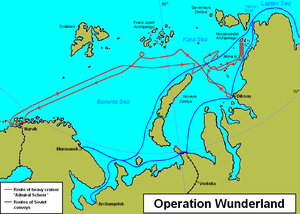- Operation Wunderland
-
Operation Wunderland Part of the Arctic Theater of World War II
Map of Operation WunderlandDate 16 August-5 October 1942 Location Northern Sea Route north of Siberia Result Moderate German success,
outcome strategically indecisiveBelligerents  Germany
Germany Soviet Union
Soviet UnionCommanders and leaders  Admiral Hubert Schmundt
Admiral Hubert Schmundt Admiral Arseniy Golovko
Admiral Arseniy GolovkoStrength 1 × heavy cruiser
3 × destroyers
Several U-boatsWeak units of the
Soviet Northern FleetCasualties and losses None Icebreaker Sibiryakov and
five cargo ships sunk.
Two cargo ships and two gunboats damaged.
Shore installations damaged or destroyed at Dikson, Uyedineniya, Cape Zhelaniya and KhodovarikhaNaval warfare
- Baltic Sea
- Black Sea
- Arctic
- Arctic Convoys
- Rösselsprung
- Wunderland
1941
1942
- Battles of Rzhev
- Toropets and Kholm
- Demyansk
- Velikiye Luki
- Mars
- 2nd Kharkov
- Case Blue
- Stalingrad
1943
1944
- Dnieper and Carpathian
- Leningrad and Novgorod
- Narva
- Hube's Pocket
- Crimea
- Jassy-Kishinev
- Karelia
- Bagration
- Lvov and Sandomierz
- 2nd Jassy-Kishinev
- Baltics
- Debrecen
- Petsamo and Kirkenes
- Hungary
1945
Silver Fox – (Reindeer – Platinum Fox – Arctic Fox) – Raid on Kirkenes and Petsamo – Operation Rösselsprung – PQ17 – Operation Wunderland – Lapland War – Petsamo-KirkenesOperation Wunderland (German: Unternehmen Wunderland) was a large-scale operation undertaken in summer 1942 by the Kriegsmarine during World War II in the waters of the Northern Sea Route close to the Arctic Ocean. The Germans knew that many ships of the Soviet Navy had sought refuge in the Kara Sea because of the protection that its ice pack provided during 10 months of the year. The naval operation to enter the Kara Sea during the summer thaw and destroy as many Russian vessels as possible was named "Operation Wunderland".
On 16 August 1942, Admiral Scheer — under Kommodore Wilhelm Meendsen-Bohlken — left Narvik and entered the Barents Sea. Along with it went U-boats Richard Beitzen.
Contents
Kara Sea
On 19 August, the German fleet rounded Cape Zhelaniya and entered the Kara Sea which was fairly free from ice during the short summer. The next day, the Arado Ar 196 seaplane on board Admiral Scheer flew to Kravkova Island in the Mona Islands and spotted three groups of Soviet ships there, with icebreakers Lenin and Krasin among them. Fog and ice floes, however, prevented the German warships from approaching. When they arrived at the Mona Islands, the Russian ships were gone. Then, Admiral Scheer turned northeast and sped towards the Nordenskiöld Archipelago.
Despite this initial setback, on 24 August, U-601 sank the Soviet steamer Kuybyshev (2,332 BRT). On the 25th, Admiral Scheer fell upon the Russian icebreaker Sibiryakov (under the command of Captain Kacharava) right off the northwest coast of Russky Island at the northern end of the Nordenskiöld Archipelago. After putting up resistance, Sibiryakov was sunk in an unequal battle. Looking for Soviet convoys to destroy, Admiral Scheer headed back to the Mona Islands, but not finding any ships there, it sailed again to the Nordenskiöld Archipelago, trying to straddle the two convoy routes coming from the Vilkitsky Strait. Since it was not able to find any more Soviet ships, Admiral Scheer decided to head southeast towards Dikson Island in order to attack the Soviet military installations there. With its powerful guns, it caused random destruction ashore at Dikson and badly damaged the ships Dezhnev and Revolutsioner which lay anchored in the harbour. Finally, on 30 August, Admiral Scheer returned to Narvik.
On 8 September, U-251 surfaced close to Uyedineniya Island and destroyed a Soviet weather station with gunfire.
Barents Sea
Among the Kriegsmarine vessels operating in the Barents Sea during the "Wunderland" operation, Soviet Secret Service (NKVD) composed of cargo ships Nord and Komsomolets and light vessels Sh-III and P-IV west of the Yugorsky Strait. Apparently there were 328 political prisoners of the NKVD on board, out of which 305 men were killed through artillery fire or drowning. Meanwhile, on 20 August, Belushya Guba with torpedoes but was unsuccessful. U-255 and U-209 emerged and bombarded Soviet targets in Mys Zhelaniya and Khodovarikha on 25 and 28 August respectively.
Conclusion
Operation Wunderland was only moderately successful. Owing to bad weather conditions and the abundance of ice floes, the vessels taking part in Operation Wunderland did not venture beyond the Vilkitsky Strait. Therefore, the Kriegsmarine campaign only affected the Barents Sea and the Kara Sea. By mid-September, it had to be stopped because of the freezing of the sea surface with thick pack-ice, especially in the Kara Sea, which freezes much earlier because it is not affected by the warmer Atlantic currents.
References
Categories:- Kara Sea
- Barents Sea
- Naval battles of World War II involving Germany
- Naval battles of World War II involving the Soviet Union
- Campaigns and theatres of World War II
- Atlantic and Arctic theatres of World War II
- Arctic convoys of World War II
- Military in the Arctic
- Military history of the Soviet Union during World War II
- Conflicts in 1942
- Kriegsmarine
Wikimedia Foundation. 2010.

